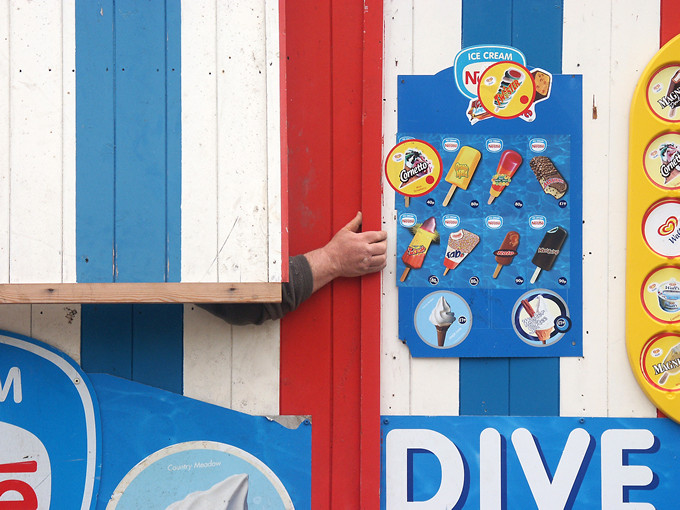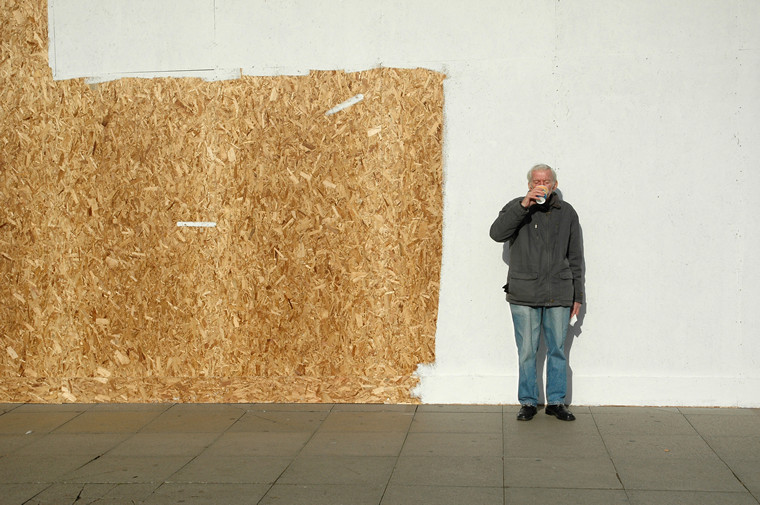Anyway, as it’s the end of the year, I’ve picked out 10 of my photos from 2008 that I liked...










About street photography, psychogeography and fast food.
















"People don’t know where they are anymore ... In the post-industrial age, this is the only form of real exploration left. Anyone can go and see the Ituri pygmy, but how many people have walked all the way from the airport to the city?"

I wonder if anyone can provide the location of this rather splendid Tony Ray-Jones photo – it’s captioned as “Bournemouth, 1969” in Russell Roberts’ Tony-Ray Jones anthology (2004). I know the area quite well and am struggling to think of anywhere that could reasonably be described as Bournemouth that overlooks these distinctive white cliffs.
It's possible that it was taken in a different part of the country altogether. In Ian Walker’s interesting essay on Tony Ray-Jones’s Tripper Boat picture in Source magazine (issue 40, autumn 2004) he describes how much of Ray-Jones’s work was wrongly captioned after his death:
“painstaking research by Ruth Kitchin at the NMPFT [National Museum of Photography, Film and Television, Bradford, UK] has shown that much of the captioning in A Day Off is wildly wrong; of the first fifty pictures in the book, only thirteen are correctly captioned, a success rate that seems almost wilfully low.”
In fact the Tripper Boat picture that Walker examines in detail in Source magazine was incorrectly captioned “Scarborough” in A Day Off – scrutiny of the contacts reveals that the location was Beachy Head, as the unmistakable Eastbourne Pier appears in the sequence.
I don’t own copies of A Day Off (1974) or Richard Ehrlich’s Ray-Jones book (1990) to chart the progress of all the captions (you’ll be relieved to hear), but many have been corrected as we come to Russell Roberts’ Tony-Ray Jones’ anthology in 2004.
Possibly the above photo has slipped through the net. Are these cliffs Beachy Head? The Isle of Wight? Somewhere else? Answers on a postcard...
"... Bacon's resort to photography, both still and cinematic, was constant, obsessive and over-the-top. Its sources and results have an enormous span, from the relatively familiar – Dr Goebbels orating, terrified crowds scattering from the tsar's police, or the bloody face of the nurse on Eisenstein's Odessa Steps, peering hysterically through her broken spectacles – to the utterly obscure. There are bits of Picture Post and images from those resources of gay porn, the body-culture magazines of the 50s. Sometimes the obscure details lie within images themselves famous. For instance, there is a well-known photograph of a racing-car at Le Mans, in which the speed of the machine and the panning camera movement turn the wheels into forward-leaning ellipses, distorted cartoonwise. So striking is this effect and so dominant the machine's image that few people so much as notice the figures in the background, on the verge of the track. But Bacon did, and he stole a pair of them, enlarging them for the right panel of Crucifixion (1965), where, in their odd soft hats, they look threateningly like a pair of Australian yobs leaning on a bar."





"Singer Pete Doherty has been blocked from performing at a music festival amid fears his band would "gee up" the crowd into a dangerous frenzy.
The decision came after police asked an intelligence officer to research Doherty's band, Babyshambles, who were booked to headline Moonfest festival in Westbury, Wiltshire, next week. They concluded that the band's tendency to "speed up and then slow down the music" could create a "whirlpool effect" and spark disorder.
...
But Superintendent Paul Williams said the ban was designed to preserve public safety. "Experts are telling us that the profile of fans that follow Pete Doherty and Babyshambles is volatile and they can easily be whipped up into a frenzy, whereas the profile of someone that would follow around Cliff Richard or Bucks Fizz, for example, is completely different."
Student James Eisen spotted them and quickly aimed his camera: 'Gazza had a bag of chips and another bag. I asked Chris if I could take his picture and he nodded. I asked Gazza and he sort of mumbled so I took the shot. One of Gazza's mates grabbed the camera and it went flying. It ended up under a car but I was able to retrieve it.










